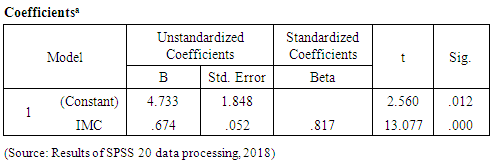-
Paper Information
- Paper Submission
-
Journal Information
- About This Journal
- Editorial Board
- Current Issue
- Archive
- Author Guidelines
- Contact Us
Management
p-ISSN: 2162-9374 e-ISSN: 2162-8416
2019; 9(3): 73-81
doi:10.5923/j.mm.20190903.02

Analysis of the End User Responses on Integrated Marketing Communication in Cognitive, Affective, and Conative Stages (Case Study on PT Go-Jek Indonesia)
Nur Hayati, Evan Jaelani
Management Department, STIE STAN Indonesia Mandiri, Bandung, Indonesia
Correspondence to: Nur Hayati, Management Department, STIE STAN Indonesia Mandiri, Bandung, Indonesia.
| Email: |  |
Copyright © 2019 The Author(s). Published by Scientific & Academic Publishing.
This work is licensed under the Creative Commons Attribution International License (CC BY).
http://creativecommons.org/licenses/by/4.0/

The purpose of this study is to analyze consumer response on integrated marketing communication in cognitive, affective, and conative stages at PT Go-Jek Indonesia Bandung Branch. The sample of this study was 87 respondents. Sampling technique in this research is purposive sampling. Data analysis method used is descriptive and Hierarchy Class analysis. The result of the descriptive analysis shows that the implementation of integrated marketing communication overall gets enough value. The program is implemented by PT Go-Jek Indonesia Bandung branch is in conative stage that gives meaning if respondent has high desire to Go-Jek product. The value of consumer feedback on IMC is significant.
Keywords: Integrated Marketing Communication, Consumer, Response, Cognitive, Affective, Conative
Cite this paper: Nur Hayati, Evan Jaelani, Analysis of the End User Responses on Integrated Marketing Communication in Cognitive, Affective, and Conative Stages (Case Study on PT Go-Jek Indonesia), Management, Vol. 9 No. 3, 2019, pp. 73-81. doi: 10.5923/j.mm.20190903.02.
Article Outline
1. Introduction
- Economics is the most important aspect. The power of economic has entered into various lines of daily life activities, whether it is in the realm of politics, social domain or other domains. The continuity of economic activities is directly proportional to the increasing mobility of information and technology aspects. This economic condition causes profit companies to continue to compete with existing sophistication. Both domestic companies and international companies expand their competitiveness at various levels, starting from low-end to high-end levels. The company's goals are widening to reach rural areas. This increasingly competition has caused companies to increas massively in finding more consumers, both permanent consumers and potential consumers are all embraced by the company with a variety of strategies.Entering new types of digital-based business into a new color in the world of modern economics, people are increasingly enjoying the economic process with integrity.One of the new types of business that many people talk about is online transportation. It is undeniable that nowadays online transportation is a new favorite of transportation that is liked by customers, the ease and level of effectiveness in online transportation have become its own advantage for it, besides being a safe and comfortable public transportation. It relatively has the same price as public transportation, and that is another advantage of online transportation. PT Go-Jek Indonesia is one of the pioneers for online transportation in Indonesia. Established in 2010 Go-Jek transformed into a new leader in the field of "shuttle (pick up and deliver)". The system offered by Go-Jek is very interesting. The transaction system carried out by Go-Jek is virtual, which reduces the waiting time that has been a problem for transportation user. In addition, the partnership offered to drivers is not pegged during working hours, it means that everyone who wants to be a partner can operate the vehicle according to their will without coercion from the company. The rise of Go-jek’s popularity is inseparable from the central role of the company's marketing media, optimal marketing communication makes Go-Jek become public transportation services. It was proven that the presence of Go-Jek changed the new order and regulation of the state about transportation, more than that, the benefit offered by PT Go-Jek could also raise the economic value of the community. Reflecting on the Go-Jek phenomenon, we can look more closely at the marketing communication process conducted by Go-Jek, this is because online transportation as a new idea can be received quickly by all levels of society. The strength of marketing communication carried out by Go-Jek is centered on internet and television media, beside that the collaboration between companies can increase the popularity of Go-Jek in the society.According to Shimp (2002: 24) Integrated Marketing Communication is the process of developing and implementing various forms of persuasive communication programs to customers and prospective customers’ continously.An important point in this study is the process of addressing the community towards Go-Jek as a new business field through an integrated marketing communication (IMC) system, in determining the communication breakthroughs, Go-Jek must also know the consumer's response to the communication tools that have been used. These responses can be in the cognitive, affective, and conative stages. The purpose of this response analysis is to determine the needs and desires of consumers, so that PT Go-Jek Indonesia as a company can redefine the strategy in its integrated marketing communication.The measurement of the response to PT Gojek Indonesia's Integrated Marketing Communication to determine the needs and desires of consumers will use a hierarchy-of-effects model that consists of cognitive stage (awareness, knowledge); affective (liking, preference, conviction); and the conative stage (purchase) described in Kotler & Keller (2006: 500). Based on the background described above, the research was carried out with the title "Analysis of The End Consumer Responses’ on Integrated Marketing Communication in the Cognitive, Affective and Conative Stages (Case Study on PT Go-Jek Indonesia)".
2. Review of Literature
2.1. Integrated Marketing Communication
2.1.1. Definition of Integrated Communication
- According to Kotler and Armstrong (2004: 247) Integrated Marketing Communication is a concept where a company integrates and coordinates communication channels to send a clear, consistent and convincing message regarding to the company and its products. Whereas according to (Baack & Kenneth, 2012: 24) (Integrated Marketing Communication (IMC) is the coordination and integration of all communication, tool and source marketing tools in a company designed to maximize the impact on customers and other end users with minimal costs). According to Belch, (2009) Integrated Marketing Communication (IMC) is a business strategy process that is used to develop, execute, evaluate, measure, a brand communication program within a certain period of time to consumers, customers, employees, and other targets both for internal and external viewers of the company. The goal is to gain financial benefits both for the short and long term and increase the value of a brand. Whereas According to Shimp, (2003: 24) Integrated Marketing Communication (IMC) is a process of developing and implementing various forms of persuasive communication programs to customers and prospective customers’ constinously. Based on the understanding of Integrated Marketing Communication (IMC) stated by several experts, it can be concluded that IMC is a combination of marketing communication modes namely Advertising, Sales Promotion, Public Relations (Publicity), Personal Selling, Sponsorship Marketing and Points-of-purchase Communication plays an important role in enhancing the brand equity of a company, therefore internal integrity / coordination of the company is needed to create mutually supportive coherence so that it can be conveyed to consumers' minds.
2.1.2. Stage of IMC Development
- According to Don Schultz, the IMC development strategy was developed through four stages. The first stage, the company simply integrates all the elements of marketing communication in one voice. The company still dominates its communication with consumers, because the message strategy and the media used are not based on the actual needs of consumers. The second stage, the attention to consumers has been done by the company, they feel the need to learn about customer experience. The company will look for new contact brands, innovative ones and outside traditional media. They began to look for alternative media that were interactive and identified all possible brand contacts. While the third stage must begin with the transformation of a consumer-based organization that supports the implementation of the IMC. This stage is an investment in information technology that supports strategic IMC needs. The company has used an accurate customer database for division-based on communication purposes. Here IMC has become a top management responsibility that must make all divisions work better together, integrated and produce synergies.In the fourth stage, the company is very sophisticated and able to implement IMC. They have the ability to calculate the ROI of each communication activity and understand its impact. Their ability to change strategies and communication tactics tends to be fast and adaptive. Here, the company will be a knowledge creation company, flexible, and able to make customized communications.Only in the third and fourth stages, IMC can be said to have surpassed the tactical level of all communication elements. In both stages, IMC has become a true integration by applying market research strategically.
2.2. Responses in the Cognitive, Affective and Conative Stages
2.2.1. Cognitive Responses
- Some cognitive understandings according to experts including; According to Drever, quoted by Nurani and Sujiono (2004: 23) stated that "cognitive is a general term that includes all models of understanding, namely perception, imagination, arrest of meaning, judgment, and reasoning". Meanwhile, according to Piaget, stated that "cognitive is how humans adapt and interpret objects and events around them." Piaget views that humans play an active role in compiling their knowledge of reality, humans are not passive in receiving information. (Nurani and Sujiono, 2004: 24) Although the process of thinking and human conception of reality has been modified by his experience with the world around him, man also actively interprets the information he gains from experience, and adapts it to knowledge and conception.
2.2.2. Affective Responses
- Consumer emotions or feelings about certain products or brands are affective responses from certain attitudes. These emotions and feelings are often considered by consumer researchers to be highly evaluative, which includes a person's assessment of the object's attitude directly and comprehensive (or to the extent that someone assesses the object's attitude 'pleasant' or 'unpleasant', 'good' or 'bad' ) Touching experiences are also considered emotional states (such as happiness, sadness, shame, disgust, anger, hardships, mistakes, or astonishment). Emotional circumstances can enhance or strengthen positive and negative experiences and that memories of these experiences can influence what arises and how individuals act (Schiffman and Kanuk, 2007: 226).
2.2.3. Conative Response
- Conative response (behavior), which is the stage where there is the possibility or tendency of an individual to take a specific action or behave in a certain way towards a particular object of attitude. According to some interpretations, the conative response includes the actual behavior itself. Conative responses are often regarded as statements of consumers' intentions to buy (Schiffman and Kanuk, 2007: 227).
2.3. End Users
- End users according to Kotler & Keller (2009: 11) are: "End users are consumers who buy products for personal use." According to Ralona M (2006), End users are users of a product or service. To get a product or service, the user is not always a buyer.
3. Theoretical Framework
- This study analyzes consumer responses regarding aspects of Integrated Marketing Communication (IMC) from cognitive, affective, and conative perceptions. IMC as a corporate communication pattern in attracting the period becomes a popular strategy at this time, the level of strategy that is run by the company has an impact on the results that will be received from the community as consumers. The response is an important point that will be discussed in this study, the use of varied communication patterns allows consumers to have more desire to become permanent customers or at least customers will try the products offered. This stage will determine the type of consumer response, including cognitive, affective, or conative.
3.1. Model Analysis and Research Hypothesis
3.1.1. Analysis Model
- Referring to the theoretical framework in the previous chapter, an analysis model of this study will be presented:
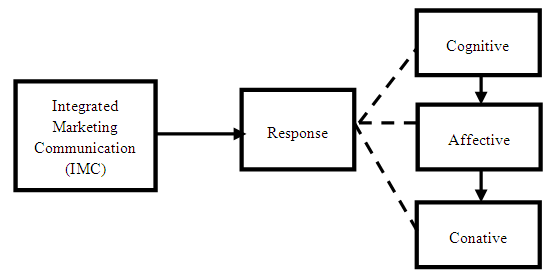 | Figure 1. Research Analysis Model |
3.1.2. Research Hypothesis
- Based on the understanding stated above, the research hypothesis is:“Integrated Marketing Communication conducted by Go-Jek Indonesia has an impact on consumer responses at the Cognitive, Affective, and Conative levels.”
4. Research Method
4.1. Research Sites
- The research carried out by the authors was in Bandung, while the location of the Bandung Branch of Go-Jek Indonesia office is on Jl. Kiaracondong, Binong, Batununggal, Bandung, West Java 40265.The research subjects analyzed were Go-Jek Indonesia consumers who specifically have riden the Go-Ride service. Go-Ride itself is a customer pick-up service from the pick-up point to the destination. Basic considerations used in determining Go-Ride as an analysis material, Go-Ride is a priority product service of Go-Jek as well as the most sought after.Based on this opinion, the population in this study is all Go-Jek consumers with specific reference to the users of the Go-Ride service. Based on interviews at the Bandung branch of the Go-Jek office, there are approximately 600-700 Go-Ride service transactions per day. Based on this opinion, the population taken is 650 transactions with consideration of the midpoint between the population numbers.
4.2. Sample
- The sample used in this study is representative of the study population, namely consumers of PT Go-Jek Indonesia. In accordance with this research where objects have a large population, thus requiring samples that are able to represent. The number of samples that will be used as research is 87 people.
5. Descriptive Analysis
- Marketing Communication design stage of marketing communication that is formed in accordance with the goals and needs of the company, so conclusions can be drawn from the definition of integrated marketing communication (IMC). PT Go-Jek Indonesia as a large company that continues to grow without realizing it has implemented the integrated marketing communication, for some of the steps taken by Go-Jek Indonesia are as follows: 1. Advertising of PT Go-Jek's step in building marketing communications is through advertising media, these steps are spread into all types of advertising media in Indonesia, both in TV, Radio, Printed Media, and Internet.
 | Figure 2. Examples of Gojek Advertising in Various Media: (1) TV Media (2) Print Media |
 | Figure 3. Public Relations and Publicity Go-Jek Indonesia: (1) Indonesian Football League Sponsorship (2) Go-Jek "Hero day" event (3) Press Release in cooperation with BPJS |
6. Analysis of Consumer Responses for Each Stage in the Hierarchy Class Model Uses Scoring Techniques
- 1. Cognitive StageBased on the results of the correspondence that has been done, a chart of the Hierarchy Class will be presented at the cognitive stage as follows:
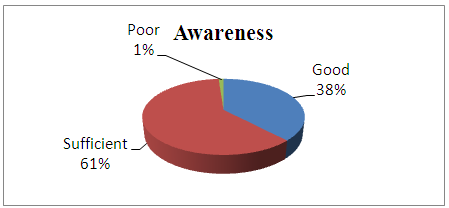 | Figure 4. Classification results at the cognitive stage of awareness dimension |
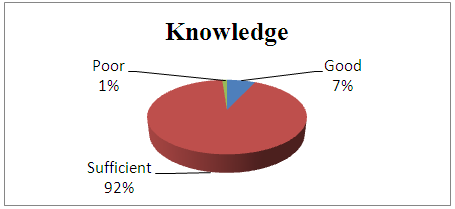 | Figure 5. Classification results in the cognitive stage of the Knowledge dimension |
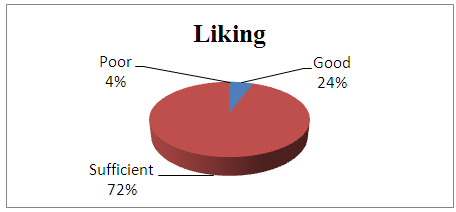 | Figure 6. classification results in the cognitive stage of the Liking dimension |
 | Figure 7. Classification results at the cognitive stage of the Preference dimension |
 | Figure 8. Classification results in the cognitive stage of the Conviction dimension |
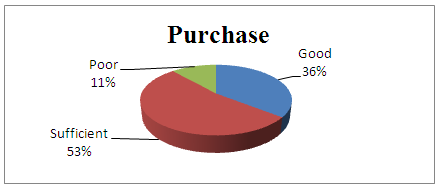 | Figure 9. Classification results in the cognitive stage of Purchase dimension |
7. Linear Regression Analysis
- Simple regression is based on the functional or causal relationship of an independent variable with one dependent variable (Sugiyono, 2011) which is stated as follows:
 Based on the data obtained the results of linear regression as follows:
Based on the data obtained the results of linear regression as follows:
|
7.1. Partial Test (t test)
- The t-test basically shows how far an individual explanatory / independent variable influences the dependent variable variation (Ghozali, 2011). Regression coefficients are used to determine the effect of Integrated marketing communication on consumer responses.The results of testing the effect of independent variables on the dependent variable are as follows:
7.2. Hypothesis Testing
- 1) First Hypothesis TestingHo: integrated marketing communication does not have a positive effect on consumer responsesHa: integrated marketing communication does have a positive effect on consumer responsesBased on Table 2 the results of the linear regression test obtained regression coefficient value of 0.674. The variable integrated marketing communication has a t-count value of 13.077 greater than t-table (1.988) with a probability of 0.000 <0.05. These results indicate that integrated marketing communication has an effect on the consumers of Go-Jek Indonesia in Bandung branch.
|
7.3. Determination Coefficient
- The coefficient of determination (adjusted R2) is used to measure the inverse of the regression equation which gives the percentage of total variation in the dependent variable which is explained by all independent variables. Adjusted R2 values range between 0 and 1 where the value of adjusted R2 is small or close to 0 means that the ability of independent variables in explaining the variation of the dependent variable is very limited, but if the value of adjusted R2 is large or close to 1 means that the independent variables provide almost all the information needed to predict the variation of the dependent variable (Ghozali, 2011). The determination coefficient test results can be seen in the table as follows:
|
7.4. Discussion, Implications and Limitations
- 1. Discussion and Determination of the Final Consumer Response to the Implementation of the Go-Jek IMC Cognitive, Affective, or Conative Phase Using Scoring Techniques.In accordance with the formulation of the problem, the purpose of the study, and the descriptive analysis method used to find out how the final consumer response to Go-Jek integrated marketing communication (IMC) is in the cognitive, affective, and conative stages, classification criteria are drawn up referring to the provisions proposed by Sugiyono (2013:135) is as follows:Search for a Maximum Score:Maximum Score = Highest Score x Amount of Item x Number of RespondentsMaximum Score = 5 x 58 x 87 = 25,230Search for a Minimum Score:Minimum Score = Lowest Score x Number of Item x Number of RespondentsMinimum Score = 1 x 58 x 87 = 5,046Finding Interval Length:Class Interval Length = (Maximum Score - Minimum Score): Many IntervalsClass Interval Length = (25,230-5,046) Classification : 3 variabelScore range : 25,230 – 5046 = 20,184Class Length : 20,184 : 3 = 6,728Based on this guideline, the classification criteria regarding the final consumer response to Go-Jek integrated marketing communication in the cognitive, affective and conative stages can be seen in table 4:
|
7.5. Implications
- 1. Theoretical ImplicationsTheoretical implications in this study are the new picture of Integrated Marketing Communication (IMC) problems used in the study. The description is the result of the reference of previous research with research that is currently developing. These theoretical implications are developed and used to strengthen the support of previous research and generate new references to be continued by other researchers who will use the same type of research.2. Practical ImplicationsThe practical implication in this study is the encouragement for Go-Jek as an online transportation company to be able to examine in depth the Integrated Marketing Communication (IMC) program that is being implemented, both in terms of promotion, personal selling, and other aspects that trigger consumers to be more loyal on the products offered, in addition to the responses of respondents as consumers of Go-Jek can be used as a new reference to increase the selling value of products needed by consumers. 3. LimitationsThis study contained several limitations that were not able to be reached when carrying out data analysis and testing, as for the limitations, namely:1. Methods of data collection using questionnaires, this is very possible that the data obtained is still subjective so it does not reflect the actual conditions.2. Testing of data carried out in the event that it cannot be transformed as a whole, the lack of data requirements and variables that support the research causes this research to be narrowed and focused on the small number of respondents. 3. The sample in this study is limited to Go-Jek service users who are in Bandung and have used Go-Jek more than once.
7.6. Suggestions
- Based on the results of the study, the authors suggest several things regarding the implementation of Go-Jek's Integrated Marketing Communications program:1. Theoretical SuggestionFor further research, it can improve the limitations of this research and it is hoped that the next researcher can develop other variables that are outside the research that can influence integrated marketing communication, and explore the theories used by researchers in this study.2. Practical advice.Based on the existing research, the researcher suggested to Go-Jek as follows:a. In the cognitive perspective Go-Jek can filter more consumers who want to know the products offered, Go-Jek is currently not evenly distributed to rural areas, so the number of consumers is still limited in certain areas.b. In the affective perspective, Go-Jek must be able to increase the selling value of the product, so that the customer's sense of interest and confidence in Go-Jek services will increase more sharply.c. In a conative perspective, Go-Jek already has potential customers who are loyal to their products, but this must be maintained carefully, because it is not impossible that other potential customers owned by Go-Jek will move to competing companies.
 Abstract
Abstract Reference
Reference Full-Text PDF
Full-Text PDF Full-text HTML
Full-text HTML